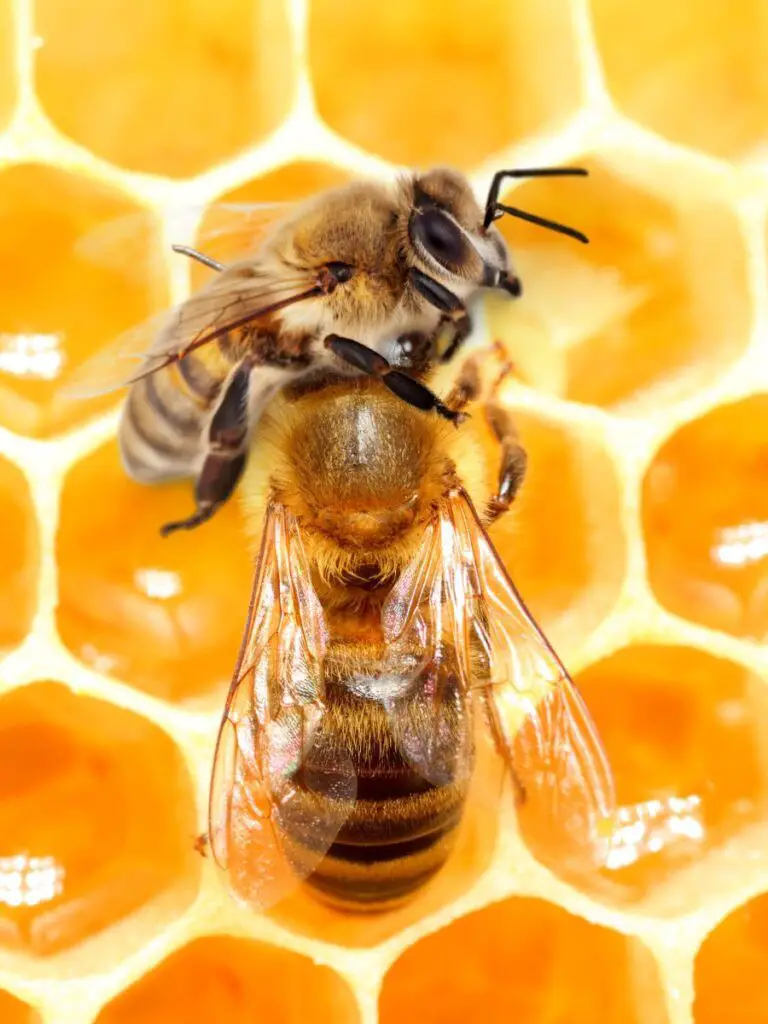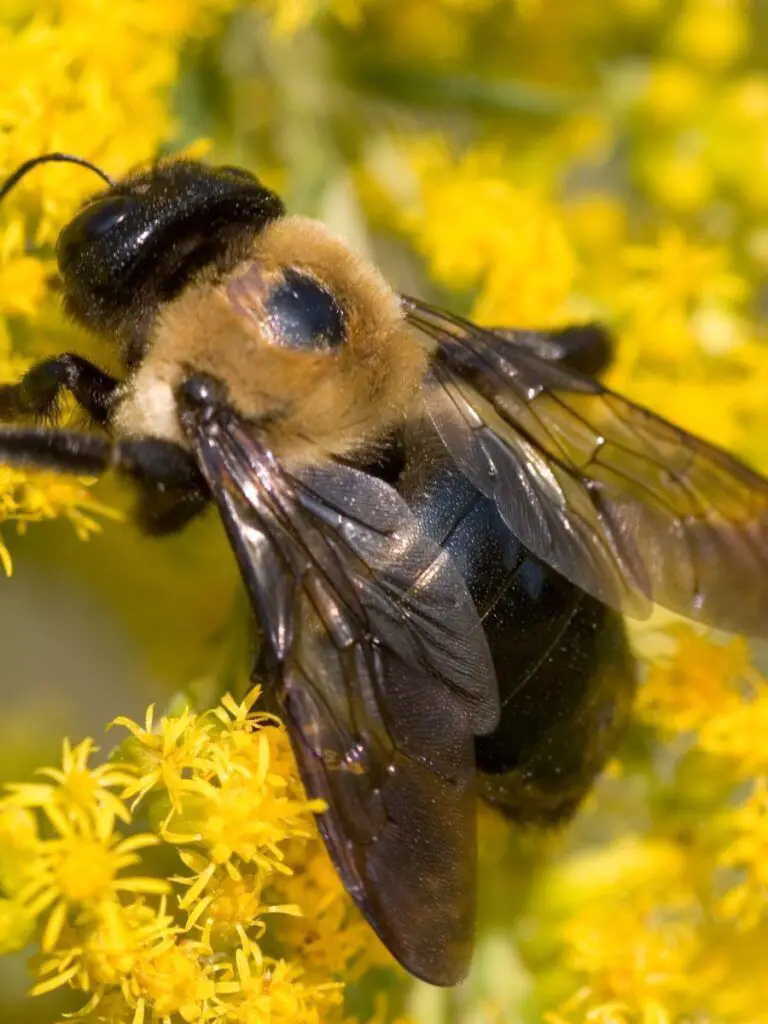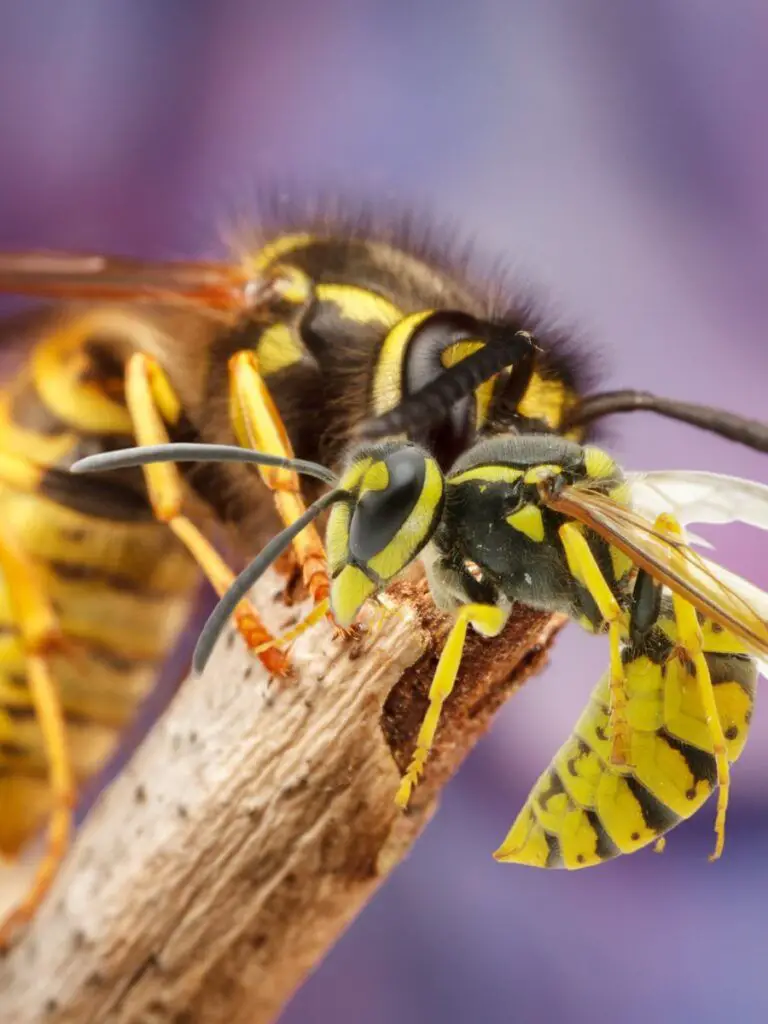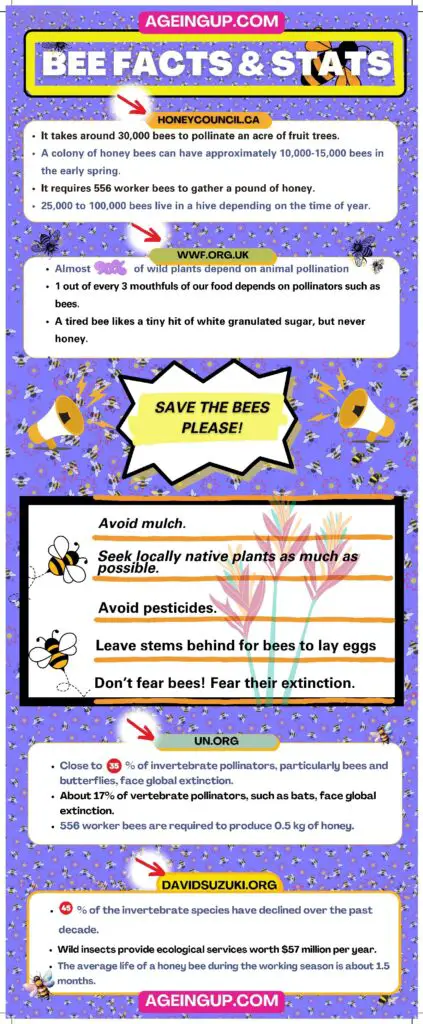As an Amazon affiliate, I may earn from qualifying purchases. Please read our Disclaimer and Privacy Policy.
Wondering how to keep bees away from your home this summer? It’s understandable, because bees can easily ruin your summer plans! Whether you’re enjoying a picnic in the park or simply trying to relax with a drink on your deck, bees can really put a sting in your plans.
Some bees, in an attempt to secure shelter, food, and suitable nesting sites, may take up residence in your home.
Not only is that a nuisance, it could be potentially dangerous for people who are allergic to bee stings.
In this post, you’ll learn nine effective ways to keep bees from moving into your home rent-free. It’s a lot easier to keep bees away from your home than it is to get rid of a nest once it’s been established.
Read this article and discover:
- why the world needs bees
- types of common bee species
- how to identify bees in your backyard or home
- how to keep bees away
- who to contact if you have an infestation of bees
Why We Need Bees
Honey bees, bumble bees, and carpenter bees play an essential role in pollination, making them crucial for our ecosystem.
Bees are vital to our ecosystem because they are pollinators. Pollination is the process by which bees transfer pollen from the male parts of flowers to the female parts. This enables plants to produce fruits, seeds, and new plants.
This process is essential for the reproduction of many flowering plants, including numerous crops that humans rely on for food.
Food Production
Did you know that bees pollinate around one-third of the food we eat? This includes fruits, vegetables, nuts, and seeds.
Crops like apples, almonds, strawberries, and tomatoes depend heavily on bee pollination. Without bees, the availability and diversity of these foods would diminish, impacting our diet and food security.
Biodiversity
Bees contribute to the health of ecosystems by pollinating wild plants. These plants provide food and habitat for a wide range of wildlife, helping to maintain biodiversity. The decline of bee populations can lead to a reduction in plant species, which in turn affects the animals that depend on them.
Economic Impact
The agricultural industry benefits significantly from bee pollination, which boosts crop yields and quality. In fact, the economic value of pollination services provided by bees is estimated to be worth billions of dollars globally.
Medicinal Plants
Many medicinal plants rely on bee pollination. The loss of bees could therefore impact the availability of plants used in traditional and modern medicine, potentially hindering medical advancements and treatments derived from plant sources.
Ecosystem Services
Beyond pollination, bees contribute to the overall health of ecosystems by supporting the growth of plants that prevent soil erosion and increase water retention. These plants also contribute to carbon sequestration, helping to mitigate climate change.
Bee Statistics:
- Close to 35% of invertebrate pollinators, particularly bees and butterflies, face extinction globally.
- Roughly 17% of vertebrate pollinators, such as bats, face extinction globally.
- According to the Bee Conservancy, habitat loss is a major factor in the decline of bee populations.
- 95% of the natural world in the United States has become “unnatural,” which negatively impacts the resources (abundant pollen and nectar sources, nesting sites, and shelter) bees need to survive.
- It’s estimated that 75% of the world’s 20,000+ bee species have a foraging range of 300 meters or less. Bees can’t survive and reproduce if food and shelter are not nearby.
- One out of every three bites of food you eat is there because of pollinators, like bees.
- More than 800 species of wild bees live in Canada.
- 4000 bee species are native to the United States.
- Roughly 10% of bees in the United States have yet to be named or described.
- One honey bee colony can gather about 40 pounds of pollen and 265 pounds of nectar in a single year.
- About 75% of North American plant species require an insect (mostly bees) to move their pollen from one plant to another.
SOURCES:
What Kind of Bees Do You Have?
The first step in managing bees is identifying the types of bees and other stinging insects you’re dealing with.
Honey bees and bumble bees are essential pollinators, while yellow jackets and paper wasps can be more aggressive. Ground bees and carpenter bees also require different approaches.
Knowing the specific area where bees are most active can help in choosing the best way to deter them. The following is a brief overview of the most commonly found bees.
Honey Bees (Apis mellifera)
Honey bees are the most well-known and essential pollinators. They are medium-sized insects, typically measuring about 0.5 to 0.6 inches in length.
They have a distinctive coloration, with golden-brown bodies and alternating dark brown to black strips on their abdomens. Honey bees have six legs equipped with structures that are used for carrying pollen back to the hive. The queen bee is the largest in the colony and she plays an important role in egg production.
Did you know that the queen honey bee can lay up to 2000 eggs per day? The other bees in a typical colony include the worker bees and the drone bees.

Bumble Bees (Genus Bombus)
Bumble bees are generally larger than honey bees, ranging from 0.6 to 1 inch in length. They have a distinct coloration of black and yellow banding on their bodies. Their bodies are covered in dense, soft hairs (known as setae) that give them a fuzzy appearance.
Carpenter Bees (Genus Xylocopa)
Carpenter bees are large and solitary in nature. They typically have shiny, black bodies, although some species may have metallic blue, green, or purple hues.
Male carpenter bees often have lighter-colored markings on their faces. They can be mistaken for bumble bees because of their size and coloration. Bumble bees, however, are social insects that live in colonies. Carpenter bees, however, would rather live alone.
If you have an infestation in your home, they’re not likely carpenter bees.

Ground Bees (Various Genera)
Ground bees, also known as mining bees or digger bees, vary in size. They typically range in size from 0.2 to 0.8 inches in length and are often brown, black, or metallic in color. Some species may have yellow, white, or red markings on their bodies.
One big difference between ground bees and other types of bees is the lack of dense, fuzzy hairs. These bees live in the soil, often in areas with little vegetation or bare ground.
Yellow Jackets (Vespula genus)
Yellow jackets are not bees at all, although they could be mistaken for a type of bee. Instead, yellow jackets are a type of wasp with black and yellow markings on their bodies. They are slender, with a narrow waist that separates the thorax from the abdomen.
Yellow jackets have smooth bodies without dense hairs. Unlike many types of bees, yellow jackets are known for their aggressive defense of their nests. They can sting repeatedly and release alarm pheromones to signal danger to the colony.
Unfortunately, yellow jackets have a tendency to build nests near people’s homes. They’re great for insect control, but not so great for home owners. In fact, they’re likely the most unwanted insects around.

How to Keep Bees Away From Your Home
1. Natural Bee Repellent
Certain scents are unpleasant to bees and may deter them from nesting near your home.
Essential oils like peppermint oil and citronella are effective natural bee deterrents. These oils can be mixed with water in a spray bottle to create a natural solution that deters bees. Simply spray the mixture around your picnic area or food table to keep bees at a safe distance.
2. Provide Bee-Friendly Plant Alternatives
Plant bee-attracting flowers and herbs away from your home to help prevent bees from nesting in your home. Choose plants that bloom at different times to provide a continuous nectar source throughout the season.
Plant these bee-attracting plants away from your home:
- Lavender
- Sunflowers
- Salvia
- Bee Balm
- Catmint
- Coneflowers
- Goldenrod
- Borage (herb)
- Cosmos
- Wildflowers
3. Remove Scents that Attract Bees
Minimize odors that attract bees by promptly cleaning up food residues, spills, and garbage, especially in outdoor eating areas.
4. Cover Food and Drinks
Bees are attracted to sugary nectar, sugary drinks, and the scent of barbecue. Use lids on food containers and trash cans to prevent bees from being drawn to these smells. Keeping food items covered and using bee guards on hummingbird feeders can also help reduce bee attraction.
5. Avoid Bright Colors and Floral Patterns
Bees are naturally attracted to bright colors, which they associate with flowers. Consider using neutral or earth-toned exterior decorations.
6. Create Alternative Water Sources
Bees need water, especially in warm weather. Providing alternative water sources away from human activity, such as shallow dishes filled with water and pebbles, can help divert bees from swimming pools and other popular spots near your property.
Fix leaky faucets, empty standing water containers, and consider installing bird baths or water features away from living areas.
7. Maintain Vegetation
Trim overgrown vegetation around your home, especially flowering plants and bushes that attract bees. Regularly mow the lawn and remove weeds to minimize potential nesting sites.
8. Citronella Candles and Banana Peels
Burning citronella candles can help keep bees at bay during outdoor gatherings. Additionally, placing banana peels in strategic locations can repel bees due to their pungent odor.
It’s important to note that there is limited scientific evidence to support the effectiveness of banana peels in repelling bees.
While some anecdotal reports suggest that placing banana peels in areas where bees are unwanted may deter them due to the scent of the peel or the potassium content, there is little empirical data to confirm this.
9. Create Physical Barriers
Seal entry points by installing screens or mesh over vents, chimneys, and other openings to prevent bees from accessing potential nesting sites indoors. Use bee-proof netting or fences to protect vulnerable areas like vegetable gardens or fruit trees.
How to Safely Deal with a Bee Infestation
Dealing with a bee infestation requires caution and consideration for your safety and for the well-being of the bees. Bees can build hives within the walls of your home, in your attic, or even in your chimney.
Tell-tale signs that you may have an infestation include the following:
- Increased bee activity around your property
- Buzzing sounds coming from the walls, ceilings, or other hidden spaces in your home.
- Visible nest or hive.
- Presence of honey or wax near the site. You may find sticky residue.
- Finding large numbers of dead bugs could indicate the presence of a nearby nest.
- Unusual smells from bee pheromones.
For those with a bee allergy, it’s crucial to take extra precautions. Carry an epinephrine auto-injector and avoid areas with high bee activity. Educating family members about the signs of severe allergic reactions can also be lifesaving.
Contact a Local Beekeeper
If you encounter a significant bee problem or find bee nests in your yard, contacting a local beekeeper or bee removal specialist is the best option. They can safely relocate the bees to a new home without harming them.
To find reputable bee keepers or bee removal experts, look for the following:
Local Beekeeping Associations
Many regions have beekeeping associations or clubs that bring together beekeepers for networking, education, and support. These associations often maintain directories of members who may offer beekeeping services or assistance with bee-related issues.
Online Directories
Online directories such as the Bee Culture Directory or the American Beekeeping Federation’s Beekeeper Locator allow you to search for beekeepers by location. These directories typically provide contact information and may include details about the beekeeper’s experience and services offered.
State or Regional Beekeeping Organizations
In addition to local associations, larger state or regional beekeeping organizations may exist in your area. These organizations may offer resources for finding beekeepers and provide additional support and education for beekeeping enthusiasts.
Word of Mouth
Asking friends, neighbors, or acquaintances for recommendations can be a valuable way to find qualified beekeepers in your area. Personal referrals can provide insights into a beekeeper’s reputation and the quality of their services.
Summary: How to Keep Bees Away
While bees are beneficial insects essential to our environment, it’s important to find effective ways to keep them at a safe distance during outdoor activities.
By using natural bee repellents, maintaining clean food areas, and seeking professional help when needed, you can enjoy a bee-free zone without compromising the health of the honey bee population.
Implementing these best practices ensures a harmonious coexistence with these vital pollinators.

DOWNLOAD AND USE THIS INFOGRAPHIC FOR YOUR OWN PURPOSES, INCLUDING BLOG POSTS!
